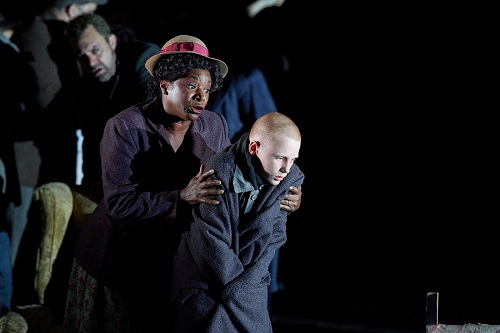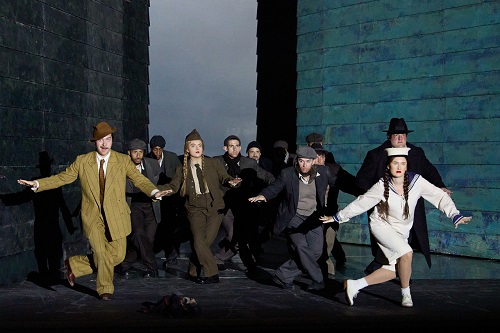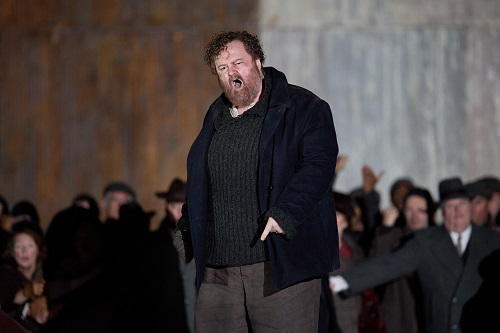David Alden may have dragged George Crabbe’s eighteenth-century Suffolk Borough into the twentieth century, updating Britten’s Peter Grimes to the time of its composition and emphasising post-war parochialism and hypocrisy, but, coming back to this 2009 ENO production after a gap of nine years, I found it to be very much a presentation of modern-day social and psychological problems and paranoias.
At times, Peter Grimes almost seemed the only ‘normal’ inhabitant of this Borough. Crabbe’s portrait of the town and its morally impoverished inhabitants is unflattering, but they are real people, engaged in real occupations. He does not satirise their loves, peccadillos, failings, entertainments and trades but depicts them with stark realism. Britten, too, in a Preface written for the first Sadlers Wells production of Peter Grimes, wrote of ‘want[ing] to express my awareness of the perpetual struggle of men and women whose livelihood depends on the sea’.
In contrast, Alden assembles a parade of grotesques, and on this occasion they seemed even more ghastly and extreme than I remember from the first revival in 2014. Swallow, all righteous officiousness in the opening court scene, ends up with his trousers round his ankles, relishing a perverse knees-up at Moot Hall. Mrs Sedley seems more witch-like than usual, brimming with repressed evil. Ned Keene is an exploitative, compassionless chancer. Sable-coated, besuited Auntie prostitutes her two nieces – twins joined at the hip, who shiver, twitch and writhe like lunatics in an asylum. When Ellen Orford brings the young apprentice through the storm and into the pub, he is clearly traumatised – shaking, contorting his arms around his head: one wonders how Grimes could make the poor boy’s suffering (which Rudy Williams conveyed brilliantly) any worse.

The cross-dressing and sexual debauchery of the Moot Hall dance scene feels anachronistic for the 1940s; these Borough inhabitants are on a road to self-destruction. “Who can turn the skies back and begin again?” asks Grimes, but that’s just what the Borough do at the end of the opera, as the women return with their fishing nets to the shore, singing of ‘the cold beginning of another day’. Grimes is gone, forgotten; the daily routines resume. But, Alden’s grotesques simply stand and stare at the audience, seemingly frozen in their alienation from each other.
The terrain of Crabbe’s poem is dominated by the reed beds and misty marshes of the Alde, whipped by the wind, rank and swampy. When he is accused of murdering his young apprentices, it seems natural that Grimes seeks sanctuary in the foul estuary of the river – a fitting landscape of the mind. Britten’s focus is the vast vistas of sea and sky, notably depicted the orchestral interludes.
In contrast, Alden gives us an almost psychotic claustrophobia, spaces and situations that have lost touch with reality. Designer Paul Steinberg’s cruelly angled interior serves as court room, fishery, public house and Grimes’s cliff-top hut. Even when we’re taken outside onto the promenade, there feels no air to breathe. As they gut and slice fish in almost catatonic slow motion, the workers stare ahead, almost blindly, their faces made garishly pale by Adam Silverman’s stark lighting. Later, the towering silhouettes that the angles of his illumination create seem almost to loom in ghostly judgement.

One wouldn’t want to spend five minutes with any of these oddballs, despite the vocal quality of the cast. Clive Bayley is forthright of voice as Swallow, and ENO Harewood Young Artist John Findon’s Bob Boles matches him for projection and weight. As her nieces (Cleo Lee-McGowan and Ava Dodd) strip to their underclothes and squirm on the floor of her tavern, Christine Rice’s succulent-toned Auntie out-stares the audience with daring defiance as she pulls her puppets’ strings. There are fine performances too from David Soar as a surly Hobson and Alex Otterburn as a slimeball Ned Keene. As Balstrode, Simon Bailey conveys all of the Captain’s frustration and impotence. Ellen Orford, sung by Elizabeth Llewellyn with piercing clarity and shine, seems less sympathetic to Grimes’s plight, though her scene with the apprentice had vocal warmth to watch the tentative sunlight which shone on the promenade.

Amongst this crowd, one might be glad to be an outcast, and in the title role Gwyn Hughes Jones was certainly that. He sang with consistent focus and, excepting some yells and cries of frustration, pain and despair, with a prevailingly compelling tone. But, I found that his tenor lacked the necessary emotive nuance. “What harbour shelters peace?”, “O the Great Bear and Pleiades”: such transfixing moments didn’t quite touch my heart as they can. Similarly, in the pit Martyn Brabbins led the ENO Orchestra in a performance of fine musicianship, but those heights of searing intensity didn’t make the impact that might have done, and I missed the unstoppable dramatic drive that Edward Gardner garnered in 2014. In particular, the sea interludes didn’t match the freedom of the domains they depict. The ENO Chorus were characteristically rousing.
All this said, there’s no doubting the striking theatrical power of Alden’s Grimes. If you don’t mind eschewing realism and the sea, then this production will give you much to think about.
Claire Seymour
Peter Grimes – Gwyn Hughes Jones, Ellen Orford – Elizabeth Llewellyn, Simon Bailey – Captain Balstrode, Auntie – Christine Rice, First niece – Cleo Lee-McGowan, Second niece – Ava Dodd, Bob Boles – John Finder, Swallow – Clive Bailey, Mrs Sedley – Anne-Marie Owens, Revd Horace Adams – Ronald Samms, Ned Keene – Alex Otterburn, Hobson – David Soar, Apprentice – Rudy Williams, Doctor Crabbe – Paul Tate; Director – David Alden, Conductor – Martyn Brabbins, Set designer – Paul Steinberg, Costume designer – Brigitte Reiffenstuel, Lighting designer – Adam Silverman, Revival Lighting designer – Gary James, Movement director – Maxine Braham, Orchestra and Chorus of English National Opera.
English National Opera, London; 21st September 2021.
ABOVE: The cast of ENO’s Peter Grimes (c) Tom Bowles